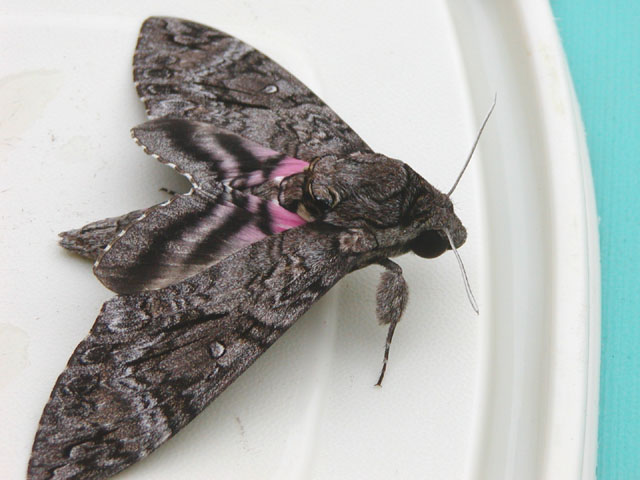
Agrius cingulata, Fairfax, Virginia, October 9, 2005, courtesy of Lisa Robinson.
|
|
Created/dedicated as per personal communication with Lisa Robinson, October 2005 Updated as per James P. Tuttle's The Hawk Moths of North America, July 22, 2010 Updated as per personal communication with Karin Moss (Manduca rustica, Alexandria, June 20, 2014); June 21, 2014 Updated as per personal communication with Brent Steury (Sphinx franckii, Turkey Run Farm, July 1, 2014); July 1, 2014 Updated as per personal communication with Laura Beaty (Eumorpha pandorus, McLean, July 19, 2014); July 19, 2014 Updated as per BAMONA, June 17, 2022 |

Agrius cingulata, Fairfax, Virginia, October 9, 2005, courtesy of Lisa Robinson.
Lisa writes, "Bill,
"Thanks to your site we were able to identify this moth that we found in our yard. We knew it was a sphinx moth, but were unsure of the specific species. We even took the moth over to a local botanical park, and were unable to find it in their field guides. Thanks to your online guide we now know what we were looking at.
"We found this specimen in our yard in Vienna, Virginia, which is in Fairfax county outside of Washington, DC. We found him today, October 9th, 2005. I am enclosing some pictures we took of the moth."
Thirty-six Sphingidae species are listed for Virginia on the BAMONA website (June 17, 2022). Not all of the species are reported or anticipated in Fairfax County (Six are reported on U.S.G.S.// June 17, 2022: 17 on BAMONA). It is hoped that this checklist, with the thumbnails and notes, will help you quickly identify the moths you are likely to encounter.A "WO" after the species name indicates that I have no confirmed reports of this species in Fairfax County or nearby counties, but I (William Oehlke) expect that this moth is present or might be present. Please help me develop this list with improved, documented accuracy by sending sightings (species, date, location), preferably with an electronic image, via email to Bill Oehlke.
Many thanks to Brent Steury, Natural Resources Program Manager, Turkey Run Park Headquarters, McLean, VA, who provides the following image:
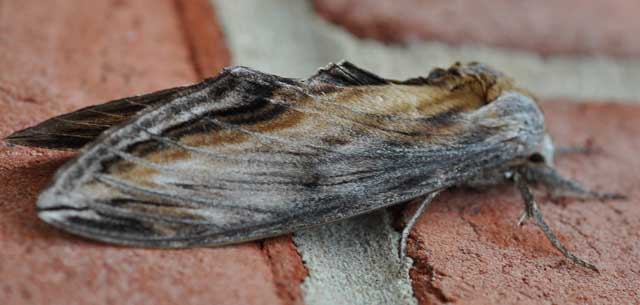
Sphinx franckii, Turkey Run Park, McLean, Fairfax County, Virginia,
July 1, 2014, courtesy of Brent Steury.
Laura sends the Eumorpha pandorus image below.
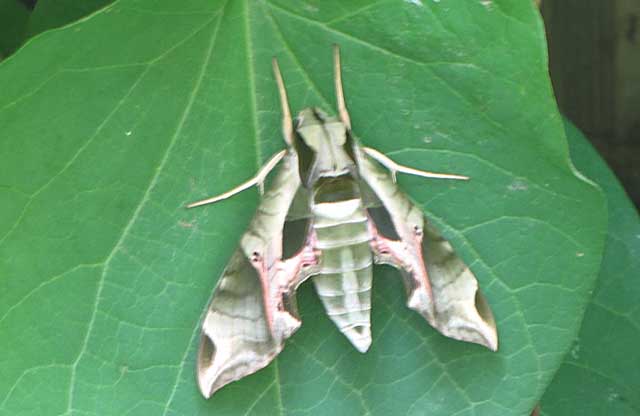
Eumorpha pandorus, McLean, Fairfax County, Virginia,
July 18, 2014, courtesy of Laura Beaty.
Visit Virginia Catocala: Underwing Moths.
Although this page was originally created to serve as a checklist for Fairfax County, it also serves as a valid checklist for nearby counties listed below.
Please send images and sightings to me, Bill Oehlke, to help improve this webpage, and also send your sighting and images to
BAMONA, a very useful project.
Caroline: none reported
Fairfax:Agrius cingulata, Ceratomia amyntor, Ceratomia catalpae, Lapara coniferarum, Manduca quinquemaculata, Manduca rustica, Manduca sexta, Paratrea plebeja,
Sphinx franckii, Amorpha juglandis, Paonias excaecata, Hemaris diffinis, Hemaris thysbe, Eumorpha fasciatus, Eumorpha pandorus, Sphecodina abbottii,
Darapsa myron.
King George: Paratrea plebeja, Paonias myops.
Loudoun: Agrius cingulata, Lintneria eremitus, Manduca quinquemaculata, Manduca sexta, Paonias excaecata, Hemaris diffinis, Hemaris thysbe,
Eumorpha fasciatus, Eumorpha pandorus, Deidamia inscriptum,
Darapsa myron, Hyles lineata
Spotsylvania: Manduca sexta, Hemaris diffinis, Eumorpha pandorus.
Stafford: Agrius cingulata, Manduca rustica, Manduca sexta, Hemaris thysbe.
The upperside of the forewing is yellowish brown with no white markings, but there are indistinct black lines and dashes. The cell spot is gray with a black outline. The larvae feed in large groups and are much more
spectacular than the moths.
less likely than next species
Larvae get very large and can strip a tomato plant.
The upperside of the forewing ranges from brown with black borders through brownish gray with paler borders to pale gray
with no borders. Dashes, submarginal line, and cell spot are usually weak.
They are common on Prince Edward Island, but are
unlikely for Fairfax County.
I regularly see them on Prince Edward Island, and they are reported
as far south as Florida.
Along the East Coast, it flies from P.E.I. to Florida.
Note the differences between this moth and the Pandorus Sphinx. Two bright, distinct, narrow yellow
bands are often visible on the abdomen.
unlikely
Hemaris diffinis, Great Falls, Fairfax County, Virginia,
May 12, 2005,
Enjoy some of nature's wonderments, giant silk moth cocoons.
These cocoons are for sale winter and fall. Beautiful Saturniidae moths will emerge the following spring and summer.
Read Actias luna rearing article.
Additional online help available. Eggs of many North American species are offered during the spring and summer. Occasionally
summer Actias luna and summer Antheraea polyphemus cocoons are available. Shipping to US destinations is done
from with in the US.
Use your browser "Back" button to return to the previous page.
This page is brought to you by Bill Oehlke and the
WLSS. Pages are on space rented from Bizland. If you would like to become a "Patron of the Sphingidae Site", contact Bill.
Please send sightings/images to Bill. I will do my best to respond to requests for identification help.
Sphinginae subfamily

Agrius cingulata,
Lisa Robinson Pink-spotted hawkmoth, Fairfax/Loudoun/Stafford:
Strong migrant; adults nectar from deep-throated flowers including moonflower (Calonyction aculeatum),
morning glory (Convolvulus), honey suckle (Lonicera) and petunia (Petunia species).

Ceratomia amyntor
Fairfax,
the Elm Sphinx or Four-horned Sphinx:
The upperside of the forewing is brown with dark brown and white markings including a white costal area near the wing base, dark streaks along the veins,
and a white spot in the cell.
Larvae feed on Elm (Ulmus), birch (Betula), basswood (Tilia), and
cherry (Prunus).

Ceratomia catalpae
USGS/Fairfax,
the Catalpa Sphinx
Catalpa is the larval host.
Ceratomia undulosa
WO, Waved
Sphinx: The upperside of the forewing is pale brownish gray with wavy black and white lines and a black-outlined white cell spot. The upperside of the hindwing is gray with diffuse darker bands.

Dolba hyloeus
WO, the Pawpaw Sphinx:
The upperside of the forewing is dark brown with a dusting of white
scales. Some moths have patches of reddish or yellowish brown on the
wings.

Lapara bombycoides
WO, the
Northern Pine Sphinx:
If you have pines, you
might have this species. It flies on P.E.I.

Lapara coniferarum
USGS/Fairfax, the Southern Pine Sphinx:
The upperside is of the forewing is gray with two
(sometimes one or three) black dashes near the wing center; other markings are usually diffuse. The upperside of the hindwing is a uniform brown-gray.
If you've got pines, this species is likely present.

Lintneria eremitus WO/Loudoun,
Hermit Sphinx:
The upperside of the forewing is gray-brown with wavy lines, black
dashes, and one or two small white spots near the center of the
costa. The upperside of the hindwing is black with two white bands
and a triangular black patch at the base. Note the golden hair on the
thorax.

Manduca jasminearum
WO, the Ash Sphinx:
The upperside of forewing is gray to grayish brown with a black line
running from the middle of the costa to the middle of the outer
margin; the line may be broken near the margin. There is a splash of
brown around the cell spot.

Manduca quinquemaculatus
Fairfax/Loudoun,
the Five-spotted Hawkmoth:
I suspect if you grow tomatoes, you are likely to encounter Manduca quinquemaculata.

Manduca rustica
Fairfax/Stafford, the Rustic Sphinx:
Look for three large yellow spots
on each side of the abdomen. The upperside of the forewing is
yellowish brown to deep chocolate brown with a dusting of white
scales and zigzagged black and white lines.

Manduca sexta
Fairfax/Loudoun/Spotsylvania/
Stafford, Carolina Sphinx:
If you grow tomatoes, you have probably encountered Manduca sexta
in the larval stage.

Paratrea plebeja
Fairfax/King George, the Plebeian Sphinx:
The upperside of the forewing is gray with indistinct black and
white markings. There is a series of black dashes
from the base to the tip, and a small white cell spot.

Sphinx chersis WO, the Northern Ash Sphinx or Great Ash Sphinx:
Larval hosts are ash,
lilac, privet, cherry, and quaking aspen.

Sphinx drupiferarum
WO,
Wild Cherry Sphinx:
We have them
on P.E.I., but I do not see them nearly as frequently
as I see the other Sphingidae.
Sphinx franckii, Turkey Run Park, McLean, Fairfax County, Virginia, July 1, 2014, Brent Steury.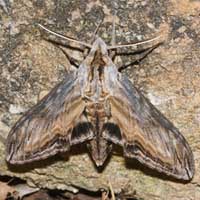
Sphinx franckii
CS/Fairfax, Franck's Sphinx Moth: The costal half of the forewings are grey, but the posterior portion
is a distinctive warm yellowish-brown; the boundary between these two areas is marked with a series of dark diagonal streaks. Similar to
S. kalmiae but lacks the dark bar along the fw inner margin.

Sphinx gordius WO, the
Apple Sphinx

Sphinx kalmiae
WO, the Laurel Sphinx:
The lower forewings are predominantly brownish-yellow with a fairly wide dark bar along the inner margin. At rest the wings hug the body,
giving the moth a long slender look.
Smerinthini Tribe:

Amorpha juglandis Fairfax/, Walnut Sphinx:
Highly variable; sometimes wings of an individual
may be all one color or may have several colors, ranging from pale to
dark brown, and may have a white or pink tinge. Patterns range from
faint to pronounced.
Female is different.

Pachysphinx modesta
WO,
the Modest Sphinx or Poplar Sphinx

Paonias astylus
WO, the Huckleberry Sphinx:
Paonias astylus flies from March-September in Florida and from
April-September in Louisiana. There is one brood northward from
June-August.
This appears to be an uncommon species.

Paonias excaecataLoudoun
the Blinded Sphinx:
Named for the dull grey-blue spot (minus dark pupil) in the hindwing,
this moth has a wide distribution in the eastern United States.
I regularly see them on Prince Edward Island, and they are reported
as far south as Florida.

Paonias myops WO//King George, the Small-eyed Sphinx:
Named for the small eye-spot in the hindwing, this moth has a wide
distribution and is probably common in Frederick County.

Smerinthus jamaicensis
WO,
the Twin-spotted Sphinx:
This moth is widely distributed and fairly common.
Macroglossinae subfamily
Dilophonotini tribe:
See Hemaris comparison to help distinguish
the next three species.

Hemaris thysbe
USGS/Fairfax/Loudoun/Stafford, Hummingbird Clearwing:
It is not difficult to see why many gardeners would mistake an
Hemaris thysbe moth for a small hummingbird as it hovers,
sipping nectar from flowers through a long feeding tube.

Hemaris diffinis
D. Champney/ USGS/Fairfax/Loudoun/
Spotsylvania,
Snowberry Clearwing or Bumblebee Moth
Adults mimic bumblebees; quite variable. Wings: basically clear, with dark brown to
brownish-orange veins, bases, edges. Thorax: golden-brown to
dark greenish-brown. Abdomen tends to be dark (black) with 1-2
yellow segments before tip.

Hemaris gracilis WO, unlikely, the
Slender Clearwing or Graceful Clearwing:
This day-flying moth is less common and has not been recorded in
Virginia, but has been seen in southern N.J. and
in eastern South Carolina and Florida. unlikely
Philampelini tribe:

Eumorpha achemon
WO,
the Achemon Sphinx:
Larvae get large and feed on grape vines and Virginia creeper.

Eumorpha fasciatus
Fairfax/Loudoun, Banded Sphinx.
Upperside: dark pinkish brown. Forewing with
lighter brown band along costa, & sharp pinkish white bands &
streaks. Primrose-willow, Ludwigia (water primrose)
& others in evening primrose family.

Eumorpha pandorus
LB/Fairfax/Loudoun/Spotsylvania, Pandorus Sphinx:
If you have Grape or Virginia Creeper nearby, then you probably have
this species.
I often get asked to identify larvae from areas not
previously reported.
Macroglossini tribe:

Amphion floridensis
WO,
the Nessus Sphinix:
This day flier is widely distributed. If you have Virginia Creeper, you
probably have the Nessus Sphinx.

Darapsa choerilus
WO, the Azalea Sphinx:
The lower wings of this hawkmoth are a solid brownish-orange,
matching the body colour.
You will often see this species listed as Darapsa pholus,
especially in older literature.

Darapsa myron USGS/Fairfax/Loudoun,
Virginia Creeper Sphinx or Grapevine Sphinx:
If you have the foodplants indicated in the common names, you probably have this
species nearby. The lower wings are orange.

Darapsa versicolor
WO,
the Hydrangea Sphinx:
If you have hydrangea growing near a stream, then you might have the
Hydrangea Sphinx.

Deidamia inscriptum
WO/Loudoun,
the Lettered Sphinx:
The moth's outer margin of the forewing is deeply scalloped.
The upperside is light brown with dark brown markings.
There is a small black and white spot near the tip.
Grape (Vitis), ampelopsis (Ampelopsis), and Virginia creeper (Parthenocissus) all serve as larval hosts.

Hyles lineata WO/Loudoun, the White-lined Sphinx:
This species has
strong migrating tendancies from much further south.
There are records from New Hampshire and Maine.

Sphecodina abbottii
USGS/Fairfax,
the Abbott's Sphinx:
This moth is very much under reported across the United States. It
is a rapid day flier so is probably not in too many collections.
Grape is a popular larval host.

Xylophanes tersa WO,
the Tersa Sphinx:
This moth is much more common to the south. It is a strong migrant,
however, and may establish itself in Frederick County periodically.
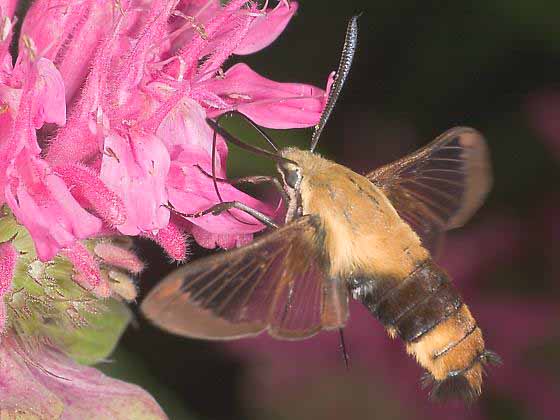
"02004 Duncan Champney. Used with permission."


Show appreciation for this site by clicking on flashing butterfly to the left.
The link will take you to a page with links to many insect sites.